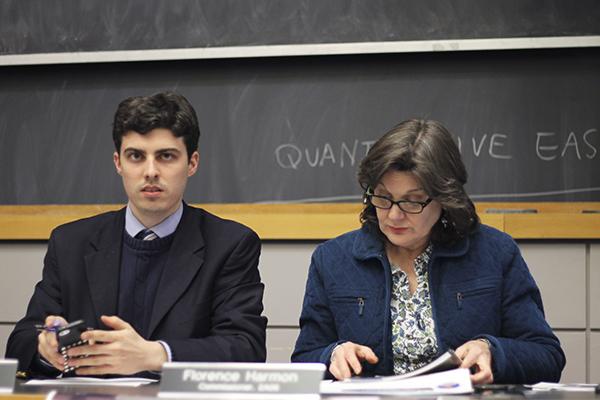Updated: April 11, 2015 at 1:12 p.m.
Leaders in the Foggy Bottom neighborhood are upset with a change GW made to its campus plan last week, saying the number of students actually on campus will no longer accurately be represented.
The D.C. Office of Zoning approved the University’s modification, which will now count students from the Corcoran School of Arts and Design who take classes or reside on Foggy Bottom as students included in its 20,000 student enrollment cap. Neighbors say this change, which will not include Corcoran students who do not take classes on Foggy Bottom or students who live off-campus, could ultimately lead to officials expanding the enrollment cap, which they said could make GW’s size in the area hard to control.
“GW wants to be transparent in how we are counting these students in the Foggy Bottom Campus Plan,” Senior Associate Vice President for Operations Alicia Knight said at last week’s hearing.
Patrick Kennedy, an alumnus and the chairman of Foggy Bottom’s Advisory Neighborhood Commission, said at the meeting that merging with other large institutions in the future could become GW’s “back door” for getting around its enrollment cap.
David Avitabile, GW’s land use counsel, said at the hearing that groups who wanted the campus plan to recognize students taking classes on any GW campus as part of the Foggy Bottom Campus were revisiting already-determined agreements for how the students will be counted.
“We understand their positions, but we just don’t agree,” Avitabile said.
About 35 Corcoran students lived in GW housing this academic year. Incoming Corcoran students will be required to live on campus through their junior year, consistent with the requirement for other GW students.
Neighbors have for years worried about GW’s footprint as its campuses have grown and developed over the past several decades.
Bob Vogt, a neighbor who lives near 24th and I streets, said in a phone interview that the additional students on campus who aren’t counted in the cap could cause officials to expand campus and eventually increase the enrollment cap to a level the area wasn’t set up to handle.
“I don’t think there’s room for GW to expand,” Vogt said. “When would it stop? When would the enrollment [increases] stop?”
Vogt also said the construction of large dormitories like District House causes problems for neighbors, because it blocks the view of the sky from their house, although its construction follows the current campus plan which requires GW to “build up, not out.”
“I don’t like that they’re building any buildings in an urban area that wasn’t built for expansion,” Vogt said.
Barbara Kahlow, a neighbor and representative of the West End Citizens Association, said at the meeting that her organization suggests including all Corcoran students under the enrollment cap because they will end up being on campus anyway.
She said counting those students would be more accurate because though some students may not take classes on Foggy Bottom or live on campus, they will end up in the area anyway to use facilities like the Lerner Health and Wellness Center, the Smith Center and Gelman Library.
She said that the new students on campus will congest sidewalks and increase competition for sidewalks.
“It’s not an incidental use. It’s a major use,” Kahlow said at the meeting.
This is one of the several battles between neighbors and officials over construction on or near campus in the past few years. In 2013, a neighbor worried that the renovation of GW Hillel, which is not owned by GW, would interfere with light coming through St. Mary’s Episcopal Church next door on 23rd and H streets. Neighbors have previously complained about construction noises from GW projects and student behavior off campus.
Jackson Carnes, an alumnus and a commissioner on the ANC, said in an interview that it makes sense for all Corcoran students to be included in the campus plan because GW acquired the Corcoran and its building on 17th Street is only a few blocks from campus.
“This is a matter of two blocks’ difference,” Carnes said. “I don’t think that you can make the case that there are different areas or neighborhoods in the city. What’s the case?”
Marina Streznewski, a Foggy Bottom resident and the president of the Foggy Bottom Association, agreed that neighbors have been worrying about the “real impact” of the additional Corcoran students. She said that there are varying opinions among neighbors about whether new buildings on campus are too tall or if they preserve the neighborhood’s atmosphere.
“People believe that neighbors should have the right to weigh in on design decisions,” Streznewski said. “This is not what the campus plan allows for.”
This post was updated to reflect the following clarification:
GW Hillel is managed and run independently of the University.








